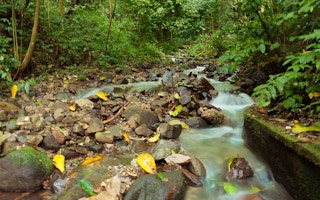A tree that abounds in West Sumatra, which is the source of a traditional herb to heal burns and diarrhoea, may provide the first antibiotic to come from Indonesia.
A team of scientists from the Indonesian Institute of Science (LIPI), led by senior researcher Andria Agusta, extracted endophytic fungi from gambier trees (Uncaria gambir) in the village of Payakumbuh in West Sumatra to study their molecular structure and found two chemical compounds, bislunatin and episitoskirin, that fit the biological classification of antibiotics.
Toxicity tests showed that bislunatin has moderate effects against seven bacteria — Bacillus subtilis, Staphylococcus aureus, Escherichia coli, Micrococcus luteus, Shigella flexneri, Proteus vulgaris and P. mirabilis. Episitoskirin indicated antimicrobial and anticancer properties, with no adverse impact on liver and renal functions or body weight gain, Agusta tells SciDev.Net.
Both chemical compounds were also found to effectively destroy pathogen bacteria, which are resistant to current generations of antibiotics. After three years, Agusta’s team are in their final phase and are likely to proceed with the clinical test next year.
The discovery may mark an important breakthrough as new antibiotics are needed in view of widespread antimicrobial resistance, which especially affects patients in surgery who are more vulnerable to infection.
Agusta says the effectiveness of antibiotics range from about 50 to 60 years only. “The antibiotics that are now in use were first produced in the 1960s. After 50 years, the bacteria have become invincible and cause infections,“ he says, noting that this particularly threatens patients struggling to survive.
Expectations are high about the extracts from the gambier trees that are considered part of West Sumatra’s daily life. “People here use gambier for traditional gum and for food flavouring,” says Ahmad Fathoni, a researcher at LIPI.
To acquire more sources of endophytic fungi, Agusta has sent a team of researchers to explore the remote island of Sumba in the hope of finding more antibiotic sources particularly deep in its unexplored caves.
Chances of getting more powerful microbes are high in the eastern part of the island, which is more geographically isolated and has extreme climates. “The trees, animals and microbes existing in this area must have much more survival power than those in the moderate [climate] areas,” notes Arie Kim, a LIPI senior researcher and taxonomy expert.
“The existence of elfin forest in Sumba’s Wangametti National Park shows this island has remained isolated for thousands of years with its rich biodiversity,” Kim adds.
This story was republished with permission from SciDev.net








